Studio Visit & Interview with WAP Artist Rick Finn
Wednesday, May 11, 2016
By Theresa Gates Kuhr
Rick Finn WAP Artist Residency September 1, 2015 – August 31, 2016
I had the pleasure of visiting Rick Finn’s Brazee Street studio last month to get an update on the evolution of his Working Artist Residency for Tiger Lily Press and to get some insight in to how he “sets up shop” and manages his career as a Cincinnati artist. During the WAP residency Rick works at TLP on Friday afternoons, but Brazee Street is still his home base. The studio was, as expected, well organized, clean, tidy, and filled with “eye candy” for printmakers. Hung on the walls were several of his lovely prints. Nicely stacked shelves lined the left wall with baskets of supplies, books, tools, papers, inks, letterpress equipment and a few bottles of wine. In the second half of the studio is where he keeps most of the printing equipment; a still shiny hotplate, a large rosin box and two presses. I counted four presses in total throughout the studio.
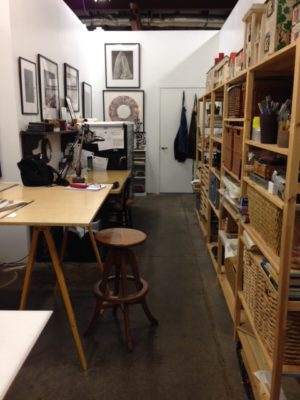
Rick is not only a talented printmaker, but is also known for his hobby of collecting and his amazing ability to display his collections. The Taft Museum capitalized on this talent several years ago when they invited Rick to organize a show of antique Christmas collectibles. The show is now an annual staple to their programming. You can sneak a peak at some of his houses on the tops of the shelves and rosin box.
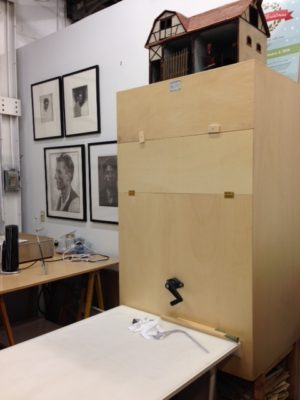
Rick allowed me to spontaneously jump right in to exploring every nook and cranny of his space, firing away questions one after the other. He humored my excitement over everything I was seeing and willingly pulled open drawers, unpacked prints, slid covers off of presses and opened the rosin box to show me how it worked. He built the rosin box that is located in the TLP studio.
Rick began working on marbelized paper in 2015 when he decided he wanted to get back into making books. His WAP proposal included a plan to incorporate hand made folios made with his marbelized papers with a letterpress project. The marbling process became a little addictive to him I think, as he showed me stacks of the beautiful papers he has created. He said it has been gratifying to experience the quick process. It makes for a nice break from his otherwise tedious print projects. When Rick works on a print he is extremely intentional, focusing many, many hours on one print for three to four months at a time, whereas with the marbled papers he can create several in a week. He plans to sell his papers at the TLP Print Sale again this year if you want to get your hands on some.
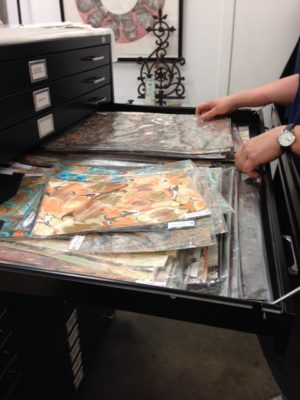
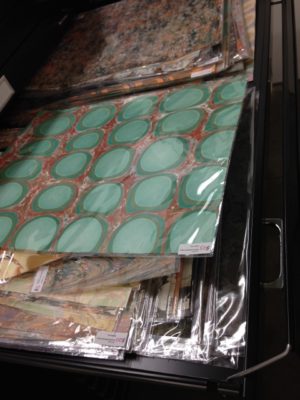
After page upon page of colored marbling, Rick began experimenting with the suminagashi technique which is a Japanese paper marbling technique that involves floating sumi ink on water in concentric rings. He has become enamored even more so with the spectacular rhythmic lines and patterns and shapes that are created with this form of marbling. The papers are absolutely gorgeous. The photos here do not do them justice so you will have to ask Rick to see them for yourself.
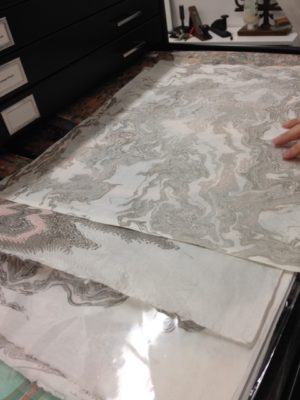
The suminagashi papers are the ones Rick decided to use to make his beautifully crafted folios. They pair well with the letterpress printed poem he has been working on that sits inside. One of the most intriguing aspects of following Rick as an artist is his affinity for fine craftsmanship in his own work and in the supplies he chooses to use. The paper that the poem is printed on is incredibly delicate and feels almost like fine cloth. It’s exquisite. He says there is just one family in Japan that makes it and it is so frail he was forced to hand press each individual letter because it would tear in the press. You can find more details on this specific project on his blog.
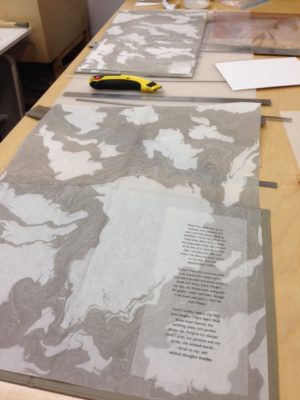
Moving on to his recently finished set of prints, a pair that include silhouettes, one of him with his mother and the other of him with his father. Each finished print is made using three separate woodblocks. The text that is layered over the images came from a piece of paper that he found on the fridge of his father’s home after his dad passed away last year. It was buried under a couple of layers of paper, still there, he believes, from when his mother was alive. It was written in her handwriting and he traced the words to a gospel song. Rick chose to use the actual handwriting for the print. He said it was quite emotional at first to be carving his mother’s handwriting, and difficult as well to master the lines of the cursive writing. But Rick has never shied away from a challenge, and I can imagine the process was very cathartic in this case. The prints will be shown in the upcoming show “Conversations” scheduled for this fall at Northern Kentucky University.
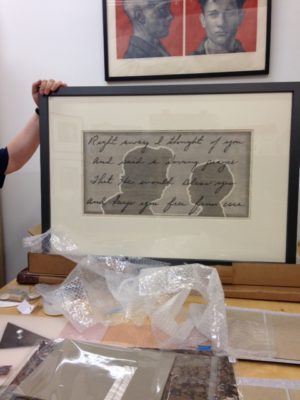
Pictured below is the largest of Rick’s presses. He is currently working on making his platen press functional and has two smaller ones that he keeps on his shelves.
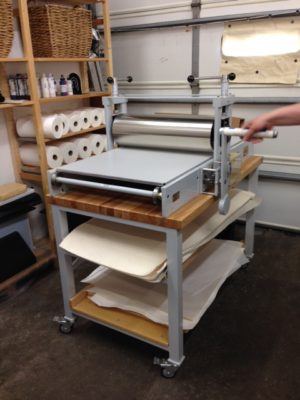
As the visit came to a close we chatted about the WAP residency and his experience over the last year. His residency will end August 31st so he will be spending the summer finishing up. He will leave one of his prints with Tiger Lily and will provide feedback on the pros and cons of his stay so that the program can be evaluated, and so that he can reflect. He has been asked to teach his marbling techniques at Tiger Lily so we will wait and see if that opportunity arises for TLP members and the public.
After spending this time with Rick I believe the residency has been a success. The goal of the program is to invite a successful local artist who may or may not be skilled in printmaking to work for six months to a year on a proposed body of work. The program serves to challenge the artist to come out of their typical working environment, engage with the Tiger Lily community through studio time, studio events and exhibitions and grow relationships with other artists with similar passions. It provides another avenue for the artist to reach out to the public with their work, and can help them grow in their artistic evolution through discussions in casual and formal settings and demonstrations of their processes. Of equal importance is the structure and motivation the program offers to complete a concise body of work. Rick has taken advantage of all of these aspects of the program.
The Tiger Lily community benefits from watching the WAP work unfold, hearing from the artist and learning from his or her techniques. The WAP artist serves as a role model for artistic expression, execution and for how to live the life of an artist amidst daily life. Rick Finn has certainly taught this to our community and we are fortunate to have him representing the best of our city.